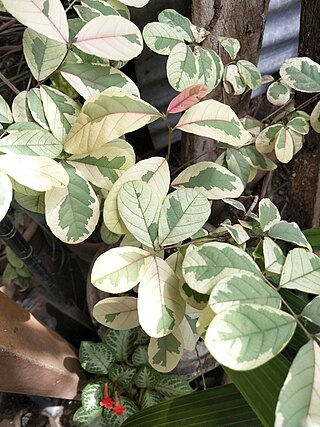
Dipterocarpus retusus, commonly known as hollong, is a large tree and perhaps the best known species in the genus Dipterocarpus. It is native to China, Vietnam, Philippines, Laos, Cambodia, Malaysia, Indonesia, Myanmar, and India. The tree, some 20–30 metres (70–100 ft) tall, is found in Cambodia in dense forests of the plains, common on hillsides and along rivers and in forests between 800 m (2,600 ft) and 1,500 m (5,000 ft) altitude.

Magnolia champaca, known in English as champak, is a large evergreen tree in the family Magnoliaceae. It was previously classified as Michelia champaca. It is known for its fragrant flowers, and its timber used in woodworking.

Allium chinense is an edible species of Allium, native to China, and cultivated in many other countries. Its close relatives include the onion, scallion, leek, chive, and garlic.

Epiphyllum oxypetalum, the Dutchman's pipe cactus, princess of the night or queen of the night, is a species of cactus with a native range from Mexico to Nicaragua. It blooms nocturnally, and its flowers wilt before dawn. Though it is sometimes referred to as a night-blooming cereus, it is not closely related to any of the species in the tribe Cereeae, such as Selenicereus, that are more commonly known as night-blooming cereus. All Cereus species bloom at night and are terrestrial plants; Epiphyllum species are usually epiphytic.
Alseodaphnopsis rugosa is a species of plant in the family Lauraceae. It is native to southeastern Yunnan province of China and northern Vietnam. It grows in mixed forests in valleys. It is threatened by habitat loss.

Anisoptera costata is an endangered species of plant in the family Dipterocarpaceae. The specific epithet costata means "ribbed", referring to the prominent venation of the leaf blade. A huge emergent tree up to 65 m high, it is found in evergreen and semi-evergreen lowland tropical seasonal forests of Indo-Burma and in mixed dipterocarp forests of Malesia.
Hopea reticulata is a species of tree in the family Dipterocarpaceae. It is native to China (Hainan) and Vietnam. Flora of China and Plants of the World Online consider Hopea exalata of Hainan a synonym of this species.

Ixonanthes reticulata is a species of plant in the Ixonanthaceae family. It is native to an area from China to India to mainland and maritime Southeast Asia. It is a broadleaf evergreen.
Gymnosporia stylosa is a species of flowering plant in the family Celastraceae. It is a scrambling shrub or tree native to Indo-China and Peninsular Malaysia. It is threatened by habitat loss.

Quercus myrsinifolia is an Asian species of tree in the beech family Fagaceae. It has several common names, including bamboo-leaf oak, Chinese evergreen oak, and Chinese ring-cupped oak. Its Chinese name is 小叶青冈; pinyin: xiǎo yè qīng gāng, which means little leaf ring-cupped oak, in Japan it is called white oak and in Korea it is known as gasinamu (가시나무). It is native to east central and southeast China, Japan, Korea, Laos, northern Thailand, and Vietnam. It is placed in subgenus Cerris, section Cyclobalanopsis.

Quercus lanata, the woolly-leaved oak, is a species of Quercus native to southern and southeastern Asia, including India, Bhutan, Nepal, Indochina, and southwestern China. It is a large evergreen tree up to 30 metres tall. The leaves are thick and leathery, green on top but covered in thick wool on the underside. It is classified in subgenus Cerris, section Ilex.

Rhododendron selense (多变杜鹃) is a rhododendron species native to southwestern Sichuan, eastern Xizang, and western Yunnan in China, where it grows at altitudes of 2,700–4,000 m (8,900–13,100 ft). It is an evergreen shrub that grows to 1–2 m (3.3–6.6 ft) in height, with leaves that are oblong-elliptic or obovate to elliptic, 4–8 by 2–4 cm in size. The flowers are pink.
Quercus bella is an uncommon species of oak tree. It is native to Guangdong, Guangxi, Yunnan, and Hainan provinces of southern China and to northern Vietnam. It is placed in subgenus Cerris, section Cyclobalanopsis.

Quercus arbutifolia, synonym Quercus obovatifolia, is a species of oak in the beech family Fagaceae, native to southeast China and Vietnam. It is placed in Quercus sect. Cyclobalanopsis, the ring-cupped oaks. There are no known subspecies.

Heptapleurum leucanthum is a species of flowering plant in the family Araliaceae and is native to south-central and southeast China, Laos, and Vietnam.
Amydrium sinense is a flowering plant in genus Amydrium of the arum family Araceae.

Bridelia ovata is a species of flowering plant in the family Phyllanthaceae, native from Indo-China to west Malesia. It was first described by Joseph Decaisne in 1834.

Mallotus peltatus is a species of flowering plant in the family Euphorbiaceae, native from India to Papuasia. It was first described by Eduard Ferdinand Geiseler in 1807 as Aleurites peltatus.
Ptychopyxis bacciformis is a species of flowering plant in the family Euphorbiaceae, native to Vietnam to Sumatra and the Philippines. It was first described by Léon Croizat in 1942.

Brassaiopsis dumicola, synonym Euaraliopsis dumicola, is a species of flowering plant in the family Araliaceae, native to China and northern Vietnam. It was first described by William Wright Smith in 1917.














